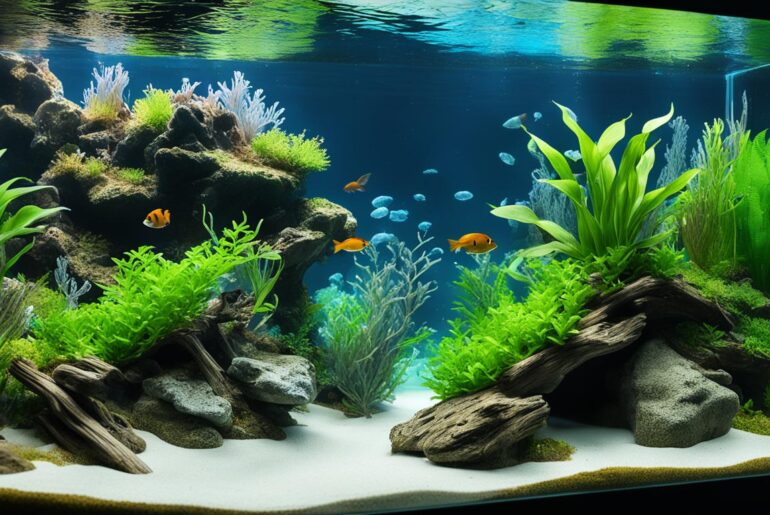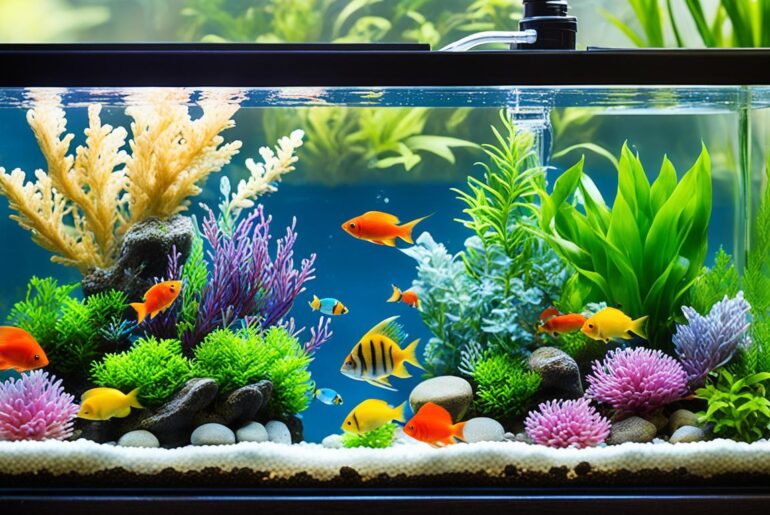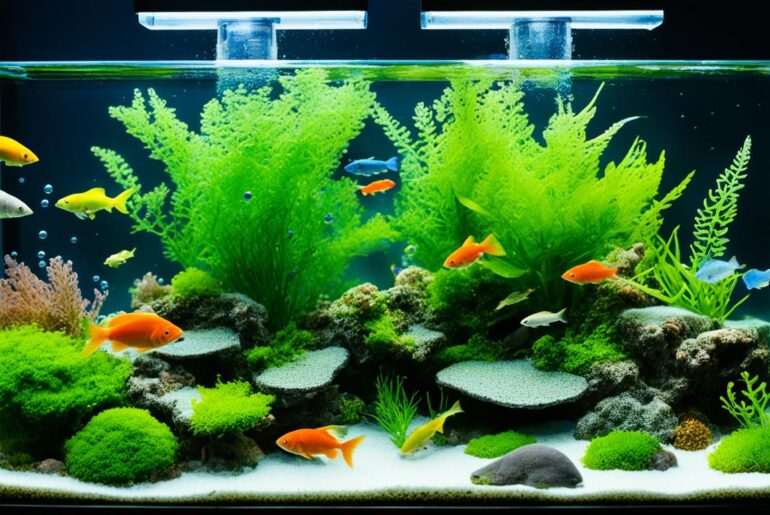Imagine the joy of setting up your very own freshwater aquarium. The anticipation of filling it with vibrant fish, the soothing sound of trickling water, and the mesmerizing beauty of an underwater world. It’s a personal sanctuary, a slice of nature within the confines of your home.
But creating a safe and healthy environment for your aquatic companions requires more than just adding water and fish. It’s a delicate process that involves understanding the timeline for freshwater aquarium cycling, the crucial step in establishing a balanced nitrogen cycle in your tank.
When I first ventured into the world of aquarium keeping, I was unaware of the intricate workings of this process. I added fish to my tank without cycling it properly, and within days, I witnessed the devastating effects. My fish fell ill, and some even succumbed to the harmful toxins that had accumulated in the water.
It was a painful lesson, but it motivated me to dive deep into the world of freshwater aquarium cycling. I learned about the importance of establishing a healthy nitrogen cycle, the role of beneficial bacteria, and the steps to ensure a thriving ecosystem for my fish.
Today, I want to share with you the knowledge I’ve gained and guide you through the essential steps to understand the timeline for freshwater aquarium cycling.
Key Takeaways:
- Creating a biologically safe environment for fish requires understanding the timeline for freshwater aquarium cycling.
- Freshwater aquarium cycling involves establishing a balanced nitrogen cycle.
- Cycling the tank is crucial for fish health and preventing “New Tank Syndrome.”
- The duration of aquarium cycling can vary but usually takes about four to eight weeks.
- There are fishless and fish-in cycling methods, each with its own benefits and considerations.
What is Aquarium Cycling?
Aquarium cycling is a vital process in creating a biologically safe environment for fish in a new tank. It involves establishing a balanced nitrogen cycle by introducing beneficial bacteria into the aquarium. These nitrifying bacteria play a crucial role in converting harmful ammonia into nitrites and then further into nitrates, effectively removing toxins from the water.
By establishing a population of beneficial bacteria, aquarium cycling ensures a stable and healthy ecosystem for your fish to thrive. These bacteria act as natural biological filters, performing the essential task of breaking down and processing fish waste. Without them, ammonia and nitrite levels can skyrocket, posing a significant threat to the fish’s health.
As the beneficial bacteria colonize and multiply, they form a robust biological filtration system in the aquarium. This filtration system is what maintains water quality by continuously converting toxic substances into less harmful compounds. The aquarium cycling process sets the stage for a thriving underwater habitat for your fish to enjoy.
The Role of Beneficial Bacteria
The establishment of beneficial bacteria is a key component of aquarium cycling. These bacteria are responsible for converting toxic ammonia and nitrites into nitrate, which is far less harmful to fish. Without this essential population of bacteria, ammonia and nitrite levels can reach dangerous levels, severely impacting the health and well-being of the fish.
“Beneficial bacteria act as nature’s little helpers, converting harmful substances into essential nutrients for aquatic life.”
Establishing beneficial bacteria is a gradual process that occurs over time during the cycling period. Initially, ammonia levels will rise as the bacteria begin to colonize. As the cycling progresses, the bacteria population grows, effectively breaking down ammonia, nitrite, and other pollutants.
It’s crucial to monitor water parameters regularly during the cycling process to ensure ammonia and nitrite levels remain within safe ranges. This helps determine when the nitrogen cycle is fully established and when it is safe to introduce fish into the aquarium.
Why is Aquarium Cycling Important?
Aquarium cycling is an essential process for ensuring the health and well-being of your fish. It plays a crucial role in creating a safe and stable environment within the tank. Let me explain the importance of aquarium cycling:
- Balance Ammonia Levels: Aquarium cycling ensures that the tank’s biological filters can handle the ammonia produced by fish waste. High levels of ammonia can be harmful to the fish and lead to health issues. By establishing the nitrogen cycle, you can effectively convert ammonia into less toxic compounds.
- Prevent New Tank Syndrome: Cycling the tank helps prevent “New Tank Syndrome,” which refers to the accumulation of toxins in a new aquarium. This condition can be detrimental to the health of your fish and may even lead to loss. Regular cycling ensures that toxins are properly removed and that the water remains safe and habitable for your fish.
- Promote Fish Health and Well-being: A cycled aquarium provides a stable environment for your fish to thrive. It reduces stress levels by maintaining optimal water parameters and minimizing the risk of harmful ammonia and nitrite spikes. Healthy water conditions promote overall fish health, allowing them to display their natural behaviors and vibrant colors.
By understanding the importance of aquarium cycling, you can create a safe, healthy, and enjoyable habitat for your fish to flourish in.
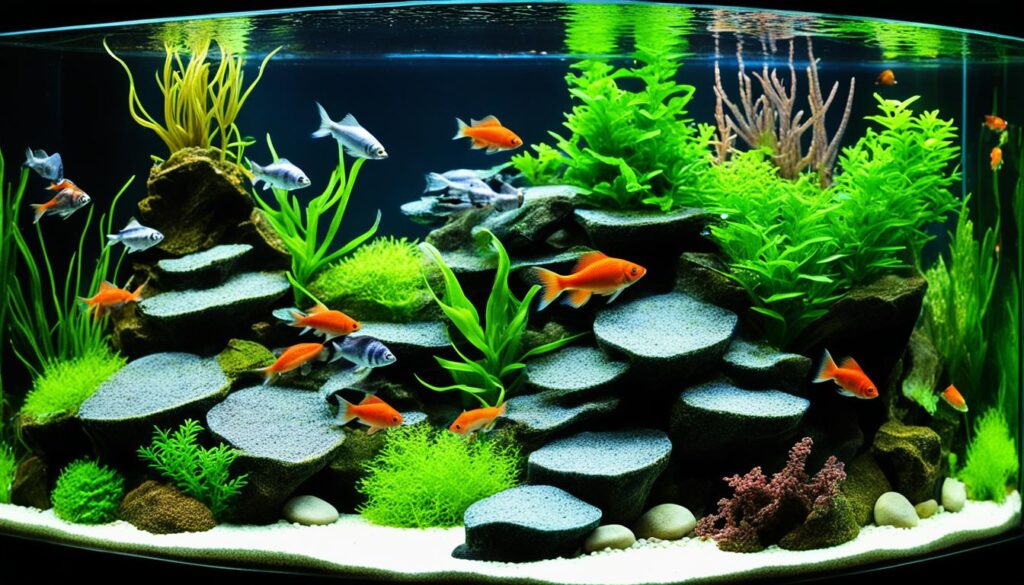
How Long Does Aquarium Cycling Take?
The duration of aquarium cycling can vary depending on several factors. These include the size of the tank, water temperature, and pH levels. Generally, it takes about four to eight weeks for an aquarium to fully cycle. However, it’s essential to monitor water parameters regularly to determine when the cycling process is complete.
To expedite the tank’s cycling and ensure a stable environment for your fish, it’s crucial to maintain the proper temperature, pH, and water quality. This will promote the growth of beneficial bacteria, which is the key to a successful cycling process.
| Factors Impacting Cycling Duration | Approximate Timeframe |
|---|---|
| Tank Size | About 4 to 8 weeks |
| Water Temperature | Can impact cycling time, generally within the expected timeframe |
| pH Levels | Can impact cycling time, generally within the expected timeframe |
By closely monitoring these factors and maintaining optimal conditions, you can ensure a successful cycling process and a safe environment for your fish.
How to Cycle an Aquarium Without Fish
One method of cycling an aquarium is the fishless cycling approach, which is recommended for beginners. This method involves adding a source of ammonia, such as fish food, to initiate the nitrogen cycle. The aquarium’s components, including pumps, filters, and substrate, should be properly set up before starting the cycling process. Regular testing of ammonia, nitrite, and nitrate levels, along with water changes as needed, will help establish a healthy population of beneficial bacteria.
To cycle an aquarium without fish, follow these steps:
- Set up the aquarium: Install the necessary equipment, including pumps, filters, and substrate. Ensure the tank is properly cleaned and conditioned for the cycling process.
- Add a source of ammonia: Add a small amount of fish food or pure ammonia to the tank. This will provide the necessary ammonia to kickstart the nitrogen cycle.
- Monitor water parameters: Regularly test the levels of ammonia, nitrite, and nitrate in the water. This will help you track the progress of the cycling process and determine when it is safe to add fish.
- Perform water changes: If ammonia and nitrite levels become too high, perform partial water changes to dilute the toxins and maintain a safe environment for the beneficial bacteria.
- Be patient: It takes time for the beneficial bacteria to establish in the tank. Avoid rushing the process and allow nature to take its course.
- Continue monitoring: Once the ammonia and nitrite levels consistently read zero, and nitrate levels are stable, the aquarium is considered cycled and ready for fish.
Cycling an aquarium without fish is a safe and effective method to establish a healthy nitrogen cycle. It allows the beneficial bacteria to grow and thrive without subjecting any fish to potentially harmful levels of ammonia and nitrite. By following these steps and being patient, you can create an optimal environment for your future fish inhabitants.
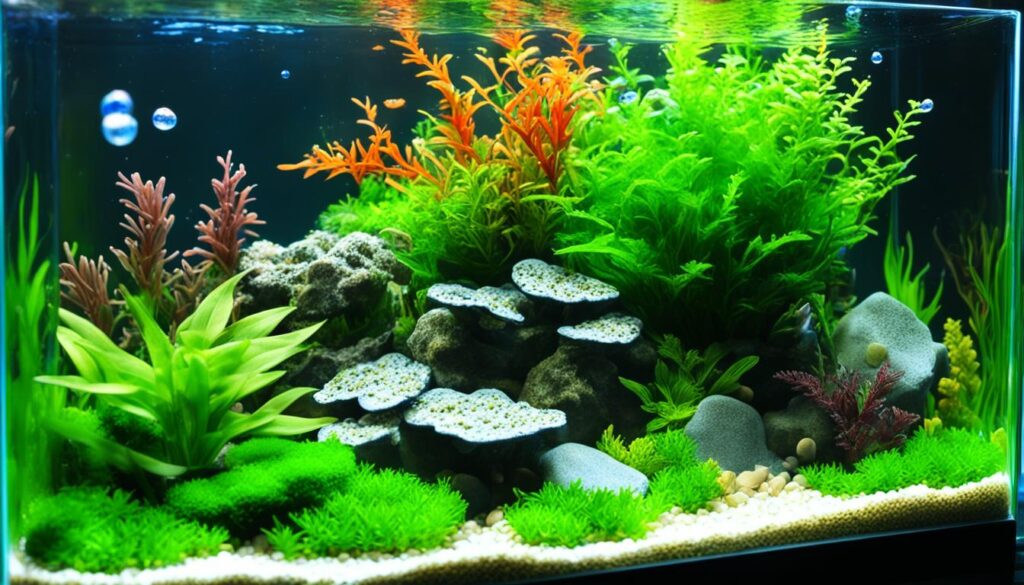
Steps to Cycle an Aquarium Without Fish
When cycling an aquarium without fish, the goal is to establish a colony of beneficial bacteria that will break down harmful toxins. Follow these steps to successfully cycle your aquarium:
- Set up the aquarium: Start by assembling and preparing the aquarium. Ensure that all equipment, such as filters and pumps, is properly installed. Add gravel, decorations, and plants to create a suitable environment for the bacteria to thrive.
- Introduce an ammonia source: To initiate the nitrogen cycle, introduce an ammonia source into the tank. This can be done by adding fish food or ammonia drops. The bacteria will consume the ammonia and convert it into nitrite.
- Monitor water parameters: Regularly test the water parameters, including ammonia, nitrite, and nitrate levels. This will help you track the progress of the nitrogen cycle. Aim for zero ammonia and nitrite, and increasing levels of nitrate.
- Perform water changes: As the nitrate levels rise, perform frequent partial water changes to keep them in check. This ensures a healthy balance of nutrients in the tank.
- Wait for the cycle to complete: The cycling process can take several weeks. Patience is essential as the beneficial bacteria colonies establish and grow. Continuously monitor the water parameters until ammonia and nitrite levels consistently read as zero.
Following these steps will help to establish a healthy population of beneficial bacteria in your fish tank, creating a stable and safe environment for future fish inhabitants. Remember to be diligent in monitoring the water parameters even after the cycle completes, as ongoing maintenance is crucial for a thriving aquarium.
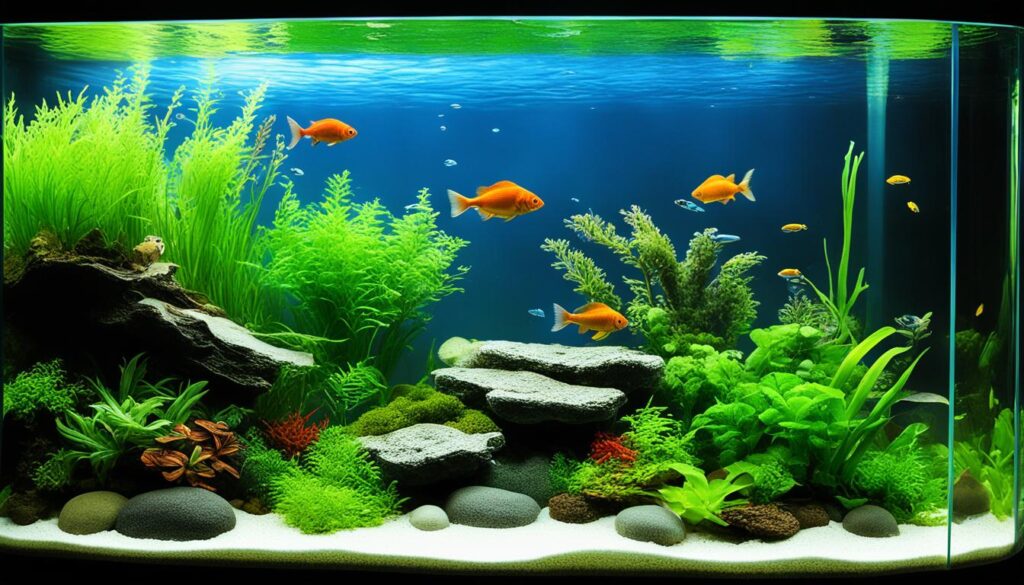
Cycling an Aquarium With Fish
When it comes to cycling an aquarium, there is an alternative approach known as fish-in cycling. In this method, the fish themselves play a crucial role in producing the ammonia necessary to initiate the nitrogen cycle. However, it’s important to note that fish-in cycling can be stressful and potentially harmful to the fish, especially if too many fish are added at once.
Frequent water changes and careful monitoring of water parameters are necessary during the fish-in cycling process. This helps maintain a healthy environment for the fish and mitigates any potential risks or discomfort they may experience. By closely observing ammonia, nitrite, and nitrate levels, you can ensure that the cycling process is progressing correctly and that the fish are not being exposed to harmful levels of toxins.
It’s crucial to prioritize the well-being and health of the fish throughout the cycling process. Implementing appropriate measures, such as regular water changes and close monitoring, safeguards their overall condition and minimizes any potential negative impacts.
“During fish-in cycling, close monitoring and regular water changes are essential to ensure the well-being of the fish.”
By maintaining a healthy environment and closely monitoring the cycling progress, you can successfully cycle your aquarium with fish. However, it’s important to exercise caution and introduce fish gradually to minimize stress and potential harm.
Fish-in Cycling Tips:
- Add fish gradually: Introduce fish to the tank in small numbers, allowing for a gradual increase in ammonia production and minimizing stress on both the fish and the tank ecosystem.
- Choose hardy fish species: Select fish species known for their resilience and ability to tolerate fluctuating water conditions, such as certain types of tetras or danios.
- Monitor water parameters closely: Regularly test ammonia, nitrite, and nitrate levels to ensure they are within safe limits for the fish.
- Perform frequent water changes: Regularly replace a portion of the water to remove accumulated toxins and prevent harmful spikes in ammonia or nitrite.
By following these tips and closely monitoring your aquarium, you can successfully cycle it with fish while ensuring the well-being and health of your aquatic pets.
Comparison of Fish-in Cycling and Fishless Cycling
| Aspect | Fish-in Cycling | Fishless Cycling |
|---|---|---|
| Ammonia Source | Fish waste | Addition of external ammonia source (e.g., fish food, pure ammonia) |
| Stress on Fish | Potentially stressful due to ammonia buildup | Fish-free environment, minimizing stress on fish |
| Control | May be challenging to control ammonia levels | More control over ammonia levels |
| Time | May take longer due to fluctuating ammonia levels | Can be faster due to controlled ammonia addition |
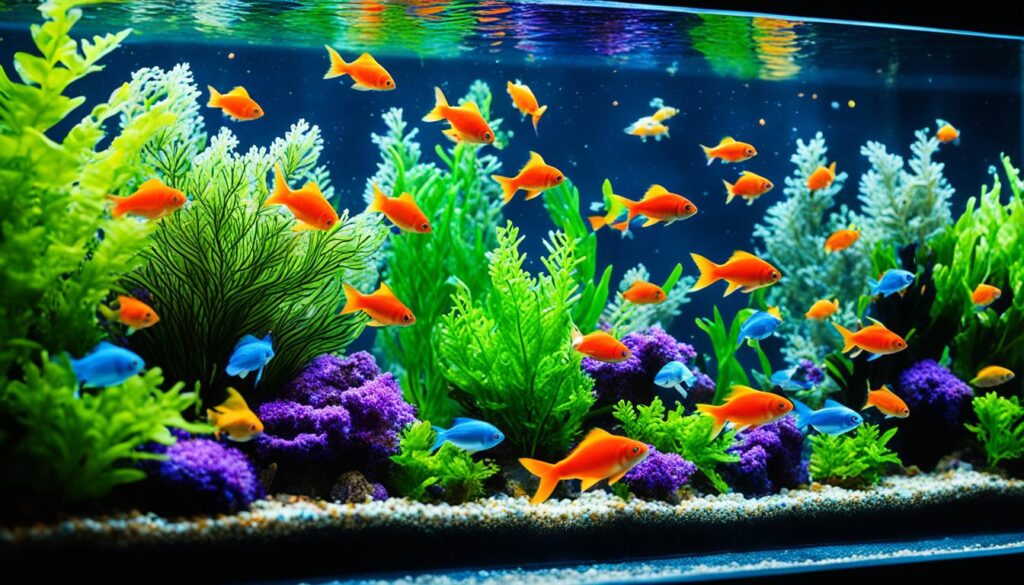
By considering the advantages and disadvantages of both fish-in cycling and fishless cycling, you can choose the method that best suits your preferences and the well-being of your fish.
Understanding the Nitrogen Cycle
The nitrogen cycle is a fundamental process in aquariums that helps break down fish waste and convert it into less harmful nitrogen compounds. This natural cycle involves beneficial bacteria that play a crucial role in maintaining a healthy environment for fish.
When fish produce waste, it releases ammonia into the water. This ammonia is toxic to fish and can be harmful if not properly dealt with. However, beneficial bacteria, known as nitrifying bacteria, transform ammonia into nitrite as part of the nitrogen cycle.
Ammonia + Nitrosomonas bacteria → Nitrite
Nitrite, although less toxic than ammonia, is still harmful to fish. Fortunately, another group of beneficial bacteria, known as nitrite-oxidizing bacteria, convert nitrite into nitrate, which is even less toxic.
Nitrite + Nitrobacter bacteria → Nitrate
Nitrates are relatively harmless to fish in low concentrations. However, they can accumulate over time, leading to water quality issues. Regular water changes help keep nitrate levels in check.
The nitrogen cycle is crucial for maintaining a healthy aquarium. It ensures that harmful ammonia and nitrite are converted into less harmful nitrate, preventing the buildup of toxins in the tank. By monitoring and maintaining the nitrogen cycle, fish enthusiasts can create an environment where their aquatic pets can thrive.
To visually illustrate the different stages of the nitrogen cycle and the role of beneficial bacteria, refer to the following table:
| Nitrogen Compound | Bacteria Involved | Conversion Process |
|---|---|---|
| Ammonia | Nitrosomonas bacteria | Ammonia is converted to nitrite |
| Nitrite | Nitrobacter bacteria | Nitrite is converted to nitrate |
| Nitrate | N/A | – |
Understanding the nitrogen cycle is essential for maintaining a healthy and balanced aquarium. By promoting the growth of beneficial bacteria and regularly monitoring water parameters, fish keepers can ensure that the nitrogen cycle efficiently processes fish waste and provides a safe environment for their aquatic companions.
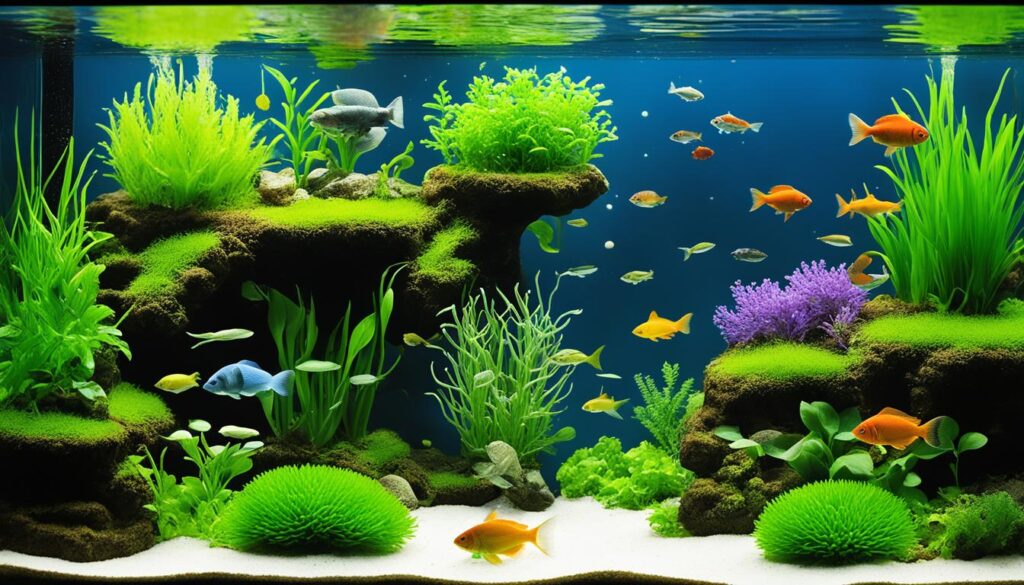
How to Increase Biological Filtration
Increasing biological filtration in an aquarium is crucial for maintaining a healthy and balanced ecosystem for your fish. By promoting the growth of beneficial bacteria and incorporating aquarium plants, you can enhance the filtration capabilities of your tank.
Adding live plants to the aquarium is a great way to increase biological filtration. These plants consume ammonia and nitrates, two common pollutants in aquariums, as a source of nutrients. As a result, they help to purify the water and create a more natural and stable environment for your fish. The addition of live plants also adds visual appeal to the tank, creating a beautiful underwater landscape.
To further enhance biological filtration, it’s essential to provide enough surface area for beneficial bacteria to colonize. This can be achieved by incorporating various elements in your aquarium, such as gravel, glass walls, and decorations. These surfaces provide a habitat for the beneficial bacteria to grow and efficiently process waste, converting harmful ammonia and nitrites into less toxic nitrates.
“The combination of beneficial bacteria and aquarium plants creates a robust biological filtration system in the tank.”
By optimizing both the growth of beneficial bacteria and the presence of aquarium plants, you create a powerful symbiotic relationship that improves the overall water quality and health of your fish. The beneficial bacteria break down waste, while the plants consume the byproducts, resulting in cleaner and healthier water.
Remember to monitor and maintain your aquarium’s biological filtration regularly. This includes testing water parameters, such as ammonia, nitrites, and nitrates, to ensure the filtration system is functioning optimally. Additionally, proper care and maintenance of the aquarium plants will help sustain their growth and filtration capabilities.
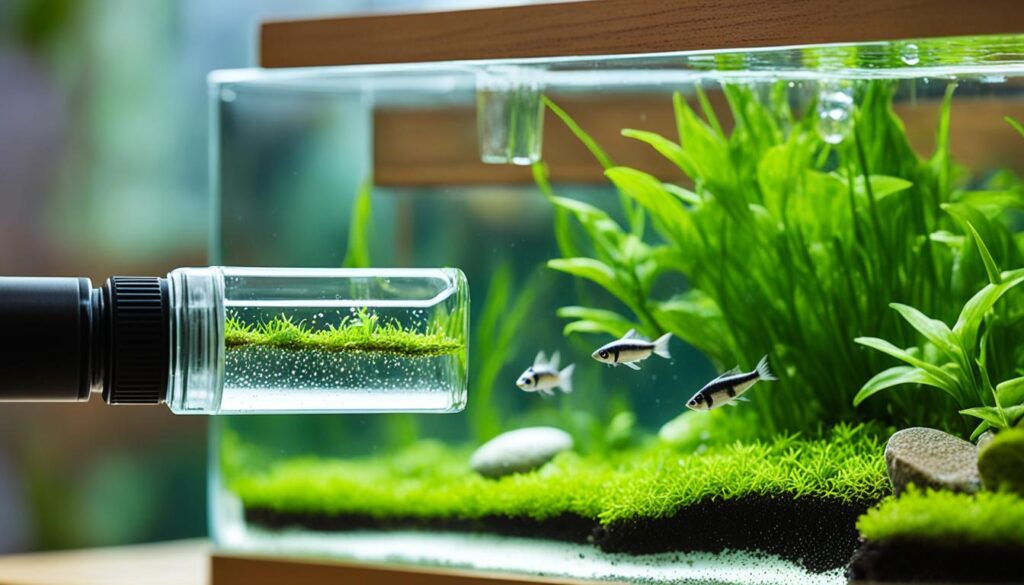
Achieving a Balanced Nitrogen Cycle
To maintain a healthy and thriving aquarium, it is crucial to achieve a balanced nitrogen cycle and maintain proper water quality. Regularly testing water parameters, such as ammonia, nitrite, nitrate, and pH levels, allows us to identify any imbalances and take appropriate action. By monitoring these parameters, we can ensure the well-being of our fish and create an optimal environment for their growth and development.
Performing regular water changes is an important step in maintaining a balanced nitrogen cycle. Regularly replacing a portion of the aquarium water helps dilute any accumulating toxins and prevent the buildup of harmful substances. It is recommended to change about 10-15% of the water every week to maintain optimal water quality and support a healthy ecosystem for our fish.
Another crucial aspect of achieving a balanced nitrogen cycle is monitoring the production of fish waste. Excessive fish waste can lead to an increase in ammonia levels, disrupting the balance in the aquarium. By regulating the number of fish and providing proper feeding habits, we can control the amount of waste produced and prevent any potential water quality issues.
Having a sufficient population of beneficial bacteria and aquarium plants is essential for maintaining a well-maintained and balanced nitrogen cycle. Beneficial bacteria, such as nitrifying bacteria, play a vital role in converting ammonia to nitrite and then to nitrate, removing harmful toxins from the water. Ensuring a suitable environment for these bacteria to thrive, such as providing proper filtration and aeration, is crucial for their growth.
Aquarium plants not only add beauty to the tank but also provide natural filtration. They help absorb excess nutrients and provide additional surface area for beneficial bacteria to colonize. Adding a variety of live plants, such as Java fern or Amazon sword, can enhance the biological filtration in the aquarium and contribute to a balanced nitrogen cycle.
Key Points:
- Regularly test water parameters to maintain optimal water quality.
- Perform regular water changes to dilute toxins and maintain a healthy environment.
- Regulate fish waste production to prevent ammonia spikes.
- Ensure a sufficient population of beneficial bacteria for efficient nitrogen cycle.
- Incorporate aquarium plants for natural filtration and additional surface area.
By following these steps and maintaining a balanced nitrogen cycle in our aquarium, we can create a thriving and sustainable environment for our fish. A well-maintained tank not only promotes the health and well-being of our aquatic pets but also provides a beautiful and enjoyable display for us to appreciate.
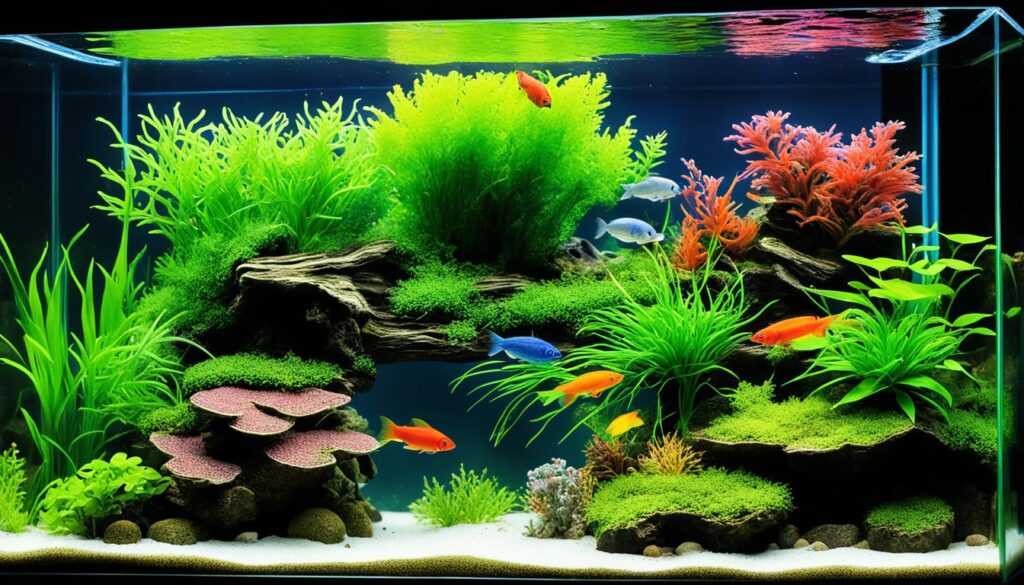
The Role of Aquarium Cycling in Fish Health
Proper aquarium cycling plays a crucial role in maintaining fish health. A cycled aquarium provides a safe and stable environment, reducing the risk of New Tank Syndrome, a condition caused by the buildup of toxins in a new aquarium. Fish in a cycled tank experience lower ammonia and nitrite levels, resulting in reduced stress and improved overall health.
The key to fish health in a cycled aquarium lies in establishing a balanced nitrogen cycle. By introducing beneficial bacteria into the tank through the cycling process, these bacteria efficiently convert toxic ammonia into nitrite, and then further break it down into less harmful nitrate.
With a well-maintained cycling process, the levels of ammonia and nitrite in the aquarium are kept at a minimum, preventing stress and potential health issues for the fish. This stable environment promotes better growth, coloration, and overall vitality in the aquatic inhabitants. Additionally, fish in a cycled tank are less susceptible to diseases and have stronger immune systems.
To ensure the well-being of the fish, it is essential to regularly monitor water parameters such as ammonia, nitrite, nitrate, and pH levels. This helps detect any imbalances in the nitrogen cycle and enables timely corrective actions to maintain the health of the fish.
“A properly cycled aquarium is the key to fish health and longevity. It provides a stable and optimized environment that mimics their natural habitat, promoting their overall well-being.”
In addition to regular monitoring, maintaining a balanced nitrogen cycle requires the proper care and maintenance of the aquarium. This includes performing regular water changes, cleaning filters, and ensuring adequate aeration. It is also beneficial to include live plants in the tank, as they not only contribute to the aesthetic appeal but also provide additional natural filtration, helping to oxygenate the water and remove excess nitrogen compounds.
By prioritizing aquarium cycling and consistently maintaining a balanced nitrogen cycle, you can create a thriving aquatic ecosystem that supports the health and vitality of your fish. A cycled aquarium offers numerous benefits, including the prevention of New Tank Syndrome and the promotion of fish health and longevity.
Remember, a healthy aquarium begins with proper cycling and ongoing care. By investing time and effort into creating and maintaining a cycled tank, you can enjoy the beauty and serenity of a flourishing aquatic environment while ensuring the well-being of your fish.
Conclusion
Understanding the timeline for freshwater aquarium cycling is crucial for creating a healthy and thriving fish tank. By establishing a balanced nitrogen cycle through the introduction of beneficial bacteria, you can ensure the removal of harmful toxins and provide a suitable environment for your fish to thrive.
Whether you choose to cycle with or without fish, maintaining proper water quality is key. Regularly monitoring water parameters such as ammonia, nitrite, nitrate, and pH levels will help you identify any imbalances and take appropriate action. Additionally, promoting the growth of beneficial bacteria and incorporating aquarium plants can contribute to a successful cycling process.
Remember, patience and attentiveness are key when it comes to aquarium cycling. By investing time and effort into maintaining a balanced nitrogen cycle, you will be rewarded with a vibrant and sustainable underwater ecosystem for your aquatic pets to enjoy. So, follow the proper steps, create a safe and healthy environment, and watch your fish thrive in their new home!
FAQ
What is aquarium cycling?
Aquarium cycling is the process of creating a biologically safe environment for fish in a new tank. It involves introducing nitrifying bacteria into the aquarium to regulate the nitrogen cycle. These bacteria help convert ammonia to nitrite and then to nitrate, removing harmful toxins from the water.
Why is aquarium cycling important?
Aquarium cycling is important because it ensures that the tank’s biological filters can handle the ammonia produced by fish waste. Without a properly cycled aquarium, fish can be exposed to high levels of ammonia, leading to health issues. Cycling the tank also helps prevent “New Tank Syndrome,” a condition caused by built-up toxins in a new aquarium.
How long does aquarium cycling take?
The duration of aquarium cycling can vary, but typically it takes about four to eight weeks for an aquarium to fully cycle. Factors such as tank size, water temperature, and pH levels can influence the timeline. Regularly monitoring water parameters such as ammonia, nitrite, and nitrate levels can help determine when the cycling process is complete.
How to cycle an aquarium without fish?
One method of fish tank cycling is the fishless cycling approach, which is recommended for beginners. This method involves adding a source of ammonia, such as fish food, to initiate the nitrogen cycle. Regular testing of ammonia, nitrite, and nitrate levels, along with water changes as needed, will help establish a healthy population of beneficial bacteria.
What are the steps to cycle an aquarium without fish?
To cycle an aquarium without fish, follow these steps: 1. Set up the aquarium components, including pumps, filters, and substrate. 2. Add a source of ammonia, such as fish food, to initiate the nitrogen cycle. 3. Regularly test ammonia, nitrite, and nitrate levels, perform water changes as needed, and monitor the growth of beneficial bacteria.
How to cycle an aquarium with fish?
Cycling a fish tank with fish involves adding the fish themselves to produce the ammonia needed to initiate the nitrogen cycle. However, this method can be stressful and harmful to the fish if not done properly. Frequent water changes and careful monitoring of water parameters are necessary to maintain a healthy environment for the fish during the cycling process.
What is the nitrogen cycle in aquariums?
The nitrogen cycle in aquariums is a natural process that breaks down fish waste and converts it into less harmful nitrogen compounds. Beneficial bacteria convert ammonia to nitrite, and then to nitrate, which is less toxic. This cycle is crucial for maintaining a healthy environment for fish and preventing the buildup of harmful toxins in the tank.
How to increase biological filtration in an aquarium?
Increasing biological filtration in an aquarium can be achieved by promoting the growth of beneficial bacteria and incorporating aquarium plants. Adding live plants helps consume ammonia and nitrates, providing natural filtration. Providing enough surface area, such as gravel, glass walls, and decorations, allows beneficial bacteria to colonize and efficiently process waste.
How to achieve a balanced nitrogen cycle in an aquarium?
To achieve a balanced nitrogen cycle in an aquarium, it is important to maintain proper water quality. Regularly test water parameters such as ammonia, nitrite, nitrate, and pH levels to identify any imbalances. Perform regular water changes, monitor fish waste production, and ensure a sufficient population of beneficial bacteria and aquarium plants to contribute to a well-maintained and balanced nitrogen cycle.
What is the role of aquarium cycling in fish health?
Proper aquarium cycling plays a crucial role in maintaining fish health. A cycled aquarium provides a safe and stable environment, reducing the risk of New Tank Syndrome, a condition caused by the buildup of toxins in a new aquarium. Fish in a cycled tank experience lower ammonia and nitrite levels, resulting in reduced stress and improved overall health.
What is the conclusion about freshwater aquarium cycling?
Freshwater aquarium cycling is essential for creating a healthy and thriving fish tank. By understanding the timeline for aquarium cycling and following the proper steps, you can establish a balanced nitrogen cycle and provide a safe environment for your fish. Whether cycling with or without fish, closely monitoring water parameters and maintaining a balanced nitrogen cycle will contribute to the well-being of your aquatic pets.

